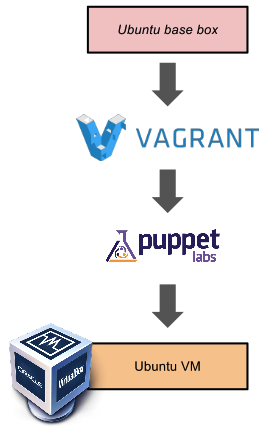Introducing people to coding the Vagrant and Puppet way
Some Context
I’m in the early stages of contemplating whether to offer a short course introduction to coding at London Business School (where, at the time of writing, I am just about to finish my own studies). An unscientific and horrendously biased survey of around 10 friends suggested strong demand. Granted a similar course at Haas running through the Spring semester is being very well received. But whilst I continue wrestle with my demand curves and logistics (booking a lecture theatre is, it turns out, up there with particle physics), I decided to explore the feasibility from a more technical side.
The scenario I imagined for the class is roughly:
- Ruby on Rails based on OpenShift
- Following a guide similar to “Getting Started with Rails”
- ~30 keen students working on personal laptops, the majority with no coding experience
- Class based tuition and take home exercises
Why OpenShift? Bit of an experiment to be honest, but the inspiration came from a recent presentation given by +ryan jarvinen at at the San Francisco offices of BranchOut
Given the inevitable smorgasbord of configurations that people will arrive with (granted the majority will be Macs) having students work in a virtual machine (VM) seems the way forward. It also means people can mess around with absolutely no fear of harming their existing setup and routine - worst comes to the worst, you download the VM and start again (this point can be refined somewhat).
So, again, at a high level (the finer details to be worked out) this is the scenario I imagined:
- VirtualBox for the virtualisation environment
- Ubuntu 12.10 for the operating system
- Gnome for the window manager - Ubuntu 12.10 uses Unity by default but my concern here is that expecting everyone to have hardware capable of supporting 3D acceleration through the VM is perhaps a step too far
- RVM for Ruby management
Creating a VM via VirtualBox is easy. Installing Ubuntu on that VM is also easy. Setting up the development environment is also easy. Configuring various settings is as easy as pointing, clicking and choosing a theme, background colour etc. But all of this takes time and if for some reason I need to repeat the exercise it would be tedious at best.
Vagrant and Puppet
Vagrant is a tool to help with building development environments. It uses VirtualBox to “build configurable, lightweight, and portable virtual machines dynamically.” That is to say, Vagrant starts with some bricks (in Vagrant terms, a base box) and helps you build a house (a VirtualBox-ready VM).
Puppet is a configuration management tool. To continue our rather tenuous house analogy, you take the house that Vagrant built and use Puppet to paint the walls, install the kitchen, put furniture in place.
The best thing about both tools is that they are declarative. That means we describe the manner in which they are constructed; with the house analogy running somewhat thin, much like an architect has plans for building a house.
Using my artistic skills, the whole process looks something like this:

What do I need to replicate this?
A short list of requirements (I have no experience of whether this works on Windows…anyone care to contribute?):
Then head over to my repository on GitHub to follow the README which will likely be more up-to-date than this article.
The results?
Well for now I have Vagrant + Puppet producing a working VirtualBox VM that is student-developer-ready. The user home directory will, in time, be sourced from GitHub which will effectively allow a student to ‘reset’ their development directory to the beginning of a class (for example).
Questions?
Please get in touch